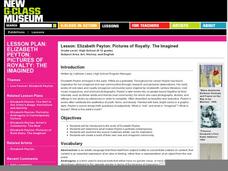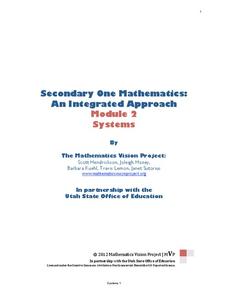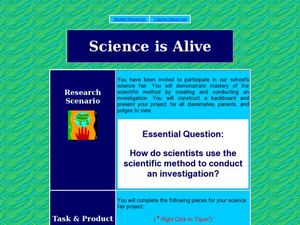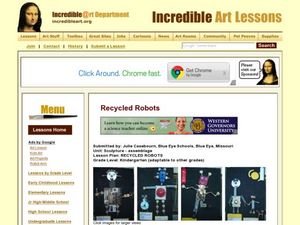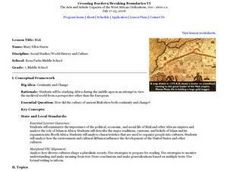Curated OER
Lesson: Elizabeth Peyton: Pictures of Royalty: The Imagined
Elizabeth Peyton is an artist who creates images of people (often famous) that she doesn't personally know. These images become part of her imagined community. Learners analyze her work, her community of imagined friends, and then create...
Mathematics Vision Project
Module 2: Systems of Equations and Inequalities
The brother-sister pair Carlos and Clarita need your class's help in developing their new pet sitting business. Through a variety of scenarios and concerns presented to the siblings, the learners thoroughly explore systems of equations...
California Department of Education
My Dream Career
Is your job a dream come true? Career seekers research to discover what their ideal jobs might be in the second of five career and college readiness lessons for sixth graders. After determining their occupational clusters, individuals...
Curated OER
Say Hi to Haibun Fun
Students examine the Japanese writing form of Haibun. They identify the elements of Japanese prose and poetry, analyze a haibun for writing devices, complete a graphic organizer, and compose an original haibun as a form of journal keeping.
Curated OER
Inventions in Everyday Life
High schoolers identify and solve problems as they modify the design of an everyday household item. They gather and analyze information and work in collaborative teams to create a design plan for a new product.
Curated OER
Life in Ancient Ghana, Mali, and Songhai
Students study the ancient African kingdoms of Ghana, Mali, and Songhai. They brainstorm what they know about ancient African kingdoms before investigating the trade and barter situations, and researching one of the kingdoms for an oral...
Curated OER
Harvest the Facts
Learners discover heath problems caused by tobacco. In this human health lesson plan, students identify the many diseases tobacco use causes and how to prevent such diseases. Learners investigate the organs in the human body directly...
Curated OER
Analyzing Two or More Nonfiction Texts
How does recognizing the author's purpose help you draw conclusions about a topic? Using two articles (both are attached), learners brainstorm why each author wrote each article. Are their purposes similar or different? Learners use a...
Scholastic
Building Trust in a Classroom
Check out these three great trust-building activities that will help your young learners understand the importance of safe, trusting relationships and environments.
National Endowment for the Humanities
Using Historic Digital Newspapers for National History Day
Your learners will take a trip through history as they peruse through historic digitalized newspapers, reading real articles from such historical periods in the United States as the Temperance movement and passage of the Thirteenth...
Curated OER
Biomes and Regions of the United States
Young scholars examine and identify the characteristics of the biomes of the world. Using the Internet, they compare and contrast the similarities and differences and discover how living things are supported in the biomes. They discuss...
Curated OER
Shakespeare and the Concepts of the Renaissance
Ninth graders familiarize themselves with the English Renaissance period and recognize the symbolism in Act V of "The Merchant of Venice" and analyze how it relates to the Italian Renaissance Themes. They produce an extended response...
Curated OER
Landmarks in Paris
Third graders create a map of France. They use computers to view an "in flight" movie about Paris. They research Paris using books and the internet. Students practice using the program "Comic Life." They import illustrations for each of...
Curated OER
Science is Alive
Students explore the scientific method. In this science lesson, students create and conduct a science investigation for the science fair.
Curated OER
Scientific Graphs
Students organize data collected from their experiments using graphs. For this statistics and biology lesson, students organize their scientific data from an article into readable graphs. They define the usefulness of their graph and...
Curated OER
Recycled Robots
Students create recycled art. In this visual art lesson, students use recycled products to assemble robotic pieces of art. Students also write stories about their robots.
Curated OER
Mali
Seventh graders begin the lesson by reading primary sources about the country of Mali. Using maps drawn in the past, they discuss what they can gather about the country from the map and how it has changed over time. They use a graphic...
Curated OER
Create Koi Nobori: Carp Kites
Students study the Japanese art of Koi Nabori or carp kites. They create their own carp kites with repeating patterns.
Curated OER
Does Word Choice Affect the Quality of a Piece of Writing?
Students discuss the importance of word choice in writing. In groups, they rank a list of words from one extreme to the other. After viewing an example, students apply their knowledge of word choice by writing a descriptive paragraph of...
Curated OER
Multimedia Morning Mania
Students interact with a morning meeting slideshow. They read, write and watch information that is projected onto a whiteboard.
Curated OER
Stem Cell Bioethics
Students study the steps of embryonic development. They distinguish between the advantages/disadvantages of embryonic stem cells vs. adult stem cells and discuss the ethical implications of stem cell research.
Curated OER
Extensions - Biology Review Unit
Students engage in a variety of activities in order to review a Biology unit. For example, they research the Bird Flu, it's history, how it is spread, what has been done about it, what better options exist for controlling or removing it....
Curated OER
Hammurabi's Code
Students explore philosophy by analyzing a historic quote. In this fairness lesson, students read a quote by Hammurabi which discusses whether law is for punishing the bad or rewarding the good. Students examine the Ten Commandments and...
Curated OER
Comparing News Sources: Where Would You Turn?
Students follow the study of Ray Bradbury's Fahrenheit 451 and attempts to connect the thematic underpinnings of the novel to Students' own lives.


